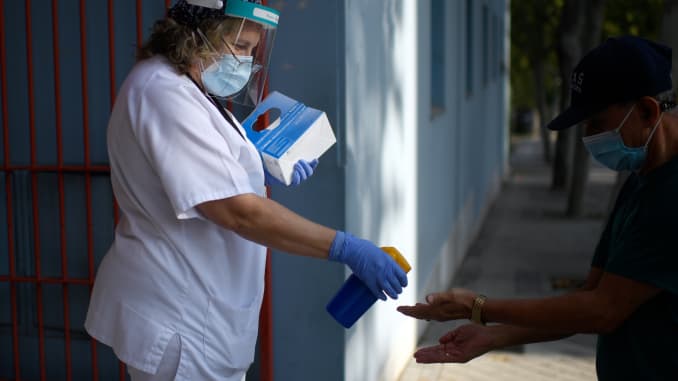- 經濟學家預測2020年下半年會反彈,但現在他們對這些預測提出質疑。
- 許多政府宣布了新的鎖定限制,或者放慢了重新開放的時間,因為冠狀病毒病例大量增加。
- 英國的警告也與此類似。英國政府週二宣布,酒吧和餐館需要儘早關閉,而工人則需要盡可能呆在家裡,而不是上下班。

歐洲現在正努力應對第二波冠狀病毒感染,這可能再次對該地區的經濟造成嚴重破壞。
歐元區是共享單一貨幣的地區,由於採取了嚴格的封鎖措施以遏制病毒的傳播,歐元區的經濟儲備在2020年第二季度增長了11.8%。
經濟學家預測2020年下半年會反彈,但現在正在質疑這些預測。許多政府宣布了新的鎖定限制,或者放慢了重新開放的時間,因為它們應對案件的大量增加。 告
ING首席經濟學家卡斯滕·布熱斯基(Carsten Brzeski)週三對CNBC表示:“出現兩次下跌的可能性,即第四季度再次出現收縮,”。
他預計未來幾週會有更多的地區封鎖,例如西班牙馬德里和法國里昂已經出現的封鎖。
歐洲疾病預防和控制中心表示,截至9月22日,歐洲已確認感染290萬例西班牙和法國,目前每天的病例已超過10,000例。
IHS Markit首席商業經濟學家克里斯·威廉姆森(Chris Williamson)週三對CNBC的 “路牌”表示,第四季度存在“雙底大風險”。
本周公布的數據顯示,9月歐元區的復蘇停滯不前。衡量製造業和服務業的歐元區快速採購經理人指數(PMI)綜合指數為50.1,僅略微進入擴張區域。最新的初步數字表明該地區的經濟活動處於三個月低位。
威廉姆森補充說:“當我們進入第四季度時,顯然還有更多的限制,這實際上將抑制增長。”
對進一步限制的經濟衝擊的擔憂使歐洲股市在本周初進入拋售模式。貝倫貝格(Berenberg)首席經濟學家霍爾格·施密丁(Holger Schmieding)在周二的報告中表示:“這種大流行構成了我們呼籲從經濟活動的三月/四月暴跌中復甦的關鍵風險。” “風險正在上升。”
英國的警告也與此類似。英國政府週二宣布,酒吧和餐館需要儘早關閉,人們應盡可能在家工作,而不是上下班。
加拿大皇家銀行的歐洲經濟學家凱瑟爾·肯尼迪(Catha Kennedy)表示,新措施“將再次主要影響服務業”,這將導致未來幾個月的商業活動放緩。
週三公佈的新數據顯示,9月份英國的閃光綜合指數為55.7。這是三個月來的最低點,突顯了英吉利海峽另一側的經濟復甦也開始失去動力。
英國科學顧問曾表示,到10月中旬,每天可能有50,000例新感染病例,而周二總理鮑里斯·約翰遜(Boris Johnson)的宣布被視為對這些嚴厲警告的直接反應。
摩根大通資產管理(JPMorgan Asset Management)全球市場策略師安布羅斯·克羅夫頓(Ambrose Crofton)在周三的一封電子郵件中表示:“感染率上升似乎再次阻礙了服務業的復蘇,這表明英國面臨艱難的道路。”
**************************************************************
- Economists predicted a rebound in the second half of 2020 but they are now questioning those forecasts.
- Many governments are announcing new lockdown restrictions, or a slowing of reopenings, as they deal with a significant uptick in cases.
- The warnings are similar for the U.K., where the government announced Tuesday that pubs and restaurants needed to close early and workers needed to stay at home, if possible, rather than commuting to the office.

Europe is now grappling with a second wave of coronavirus infections that could once again wreak significant damage on the region’s economy.
The euro zone, the area that shares the single currency, saw its economy tank by 11.8% in the second quarter of 2020, hit by strict lockdown measures used to contain the spread of the virus.
Economists predicted a rebound in the second half of 2020 but are now questioning those forecasts. Many governments are announcing new lockdown restrictions, or a slowing of reopenings, as they deal with a significant uptick in cases.
“The likelihood of a double dip, i.e. another contraction in the fourth quarter, has increased significantly,” Carsten Brzeski, a chief economist at ING, told CNBC Wednesday.
He expects more regional lockdowns in the coming weeks such as those already seen in Madrid, Spain, and Lyon, France.
The European Centre for Disease Prevention and Control said that as of Sep. 22, there had been 2.9 million confirmed infections in Europe with Spain and France now seeing daily cases rise above the 10,000 mark.
There is a “big risk of a double dip” in the fourth quarter, Chris Williamson, the chief business economist at IHS Markit, told CNBC’s “Street Signs” on Wednesday.
Data out this week showed that the recovery has stalled in the euro zone in September. The flash euro zone PMI (purchasing managers’ index) composite index — which measures both manufacturing and services — stood at 50.1, just marginally pushing into expansion territory. This latest preliminary number points to a three-month low in economic activity for the region.
“As we head through to (the) fourth quarter, there’s obviously a lot more restrictions in place and that’s really going to curb growth,” Williamson added.
Concerns on the economic shock of further restrictions sent European equities into sell-off mode earlier this week. “The pandemic poses the key risk to our call for a tick-shaped recovery from the March/April plunge in economic activity,” Holger Schmieding, chief economist at Berenberg said in a note Tuesday. “The risk is rising.”
The warnings are similar for the U.K., where the government announced Tuesday that pubs and restaurants needed to close early and people should work from home if possible, rather than commuting to the office.
Cathal Kennedy, RBC’s European economist, said that the new measures “will again primarily affect the services sector” and that will lead to slower business activity in the coming months.
The flash composite index for the U.K. came in at 55.7 in September, new data out on Wednesday showed. This was a three-month low and highlighted that the economic recovery has also started to lose momentum on the other side of the English Channel.
British scientific advisors have said there could be 50,000 new infections a day by mid-October and Tuesday’s announcements by Prime Minister Boris Johnson were seen as a direct response to those stark warnings.
“It seems apparent once more that higher infections will impede the recovery of the services sector and suggests a difficult road ahead for the U.K.,” Ambrose Crofton, global market strategist at JPMorgan Asset Management, said in an email Wednesday.
沒有留言:
張貼留言